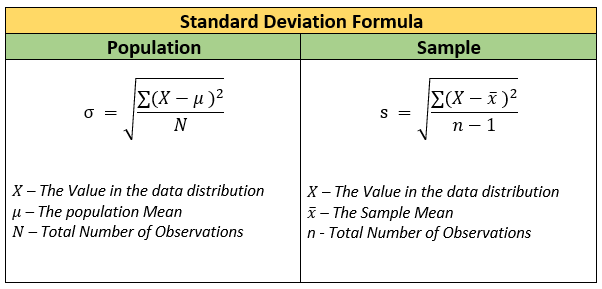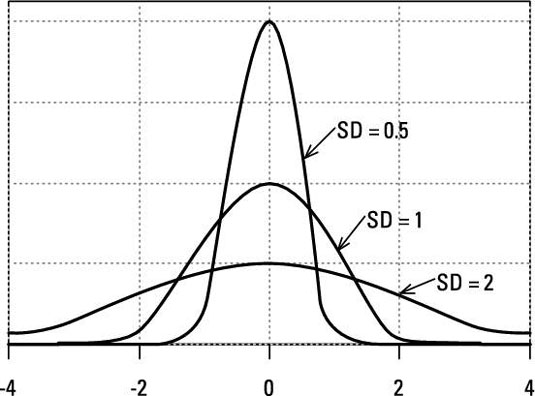Standard Deviation Vs Variance | Diffen › science › statistics. Variance is expressed in much larger units (e.g., meters squared). Variance is the mean or average of the squares of the deviations or differences in the values from the mean. Standard deviation tells us how spread out a set of numbers (a population) are. These concepts are popular in the fields of finance, investments and economics.
The standard deviation is expressed in the same units as the mean is, whereas the variance is expressed in squared units, but for looking at a distribution, you can use either just so long as you are clear about what you are using. This will eliminate the problem of squared units, and gives us a measure of the spread that. In statistics, the population standard deviation is represented by the greek letter sigma In statistics, the standard deviation is a measure of the amount of variation or dispersion of a set of values. Standard deviation and variance are statistical measures of dispersion of data , i.e., they represent how much variation there is from the average, or to what extent the values typically deviate from the mean (average).
It calculates the typical distance of a data point from the mean of the data. Variance is the average squared deviations from the mean, while standard deviation is the square root of this number. Variance and standard deviation definition and calculation. These numbers help traders and investors determine the volatility of an investment and therefore allows them to make educated trading. Both variance and the standard deviation is a measure of the spread of the elements in a data set from its mean value. Variation is the common phenomenon in the study of statistics because had there been no variation in a data, we probably would not need statistics in the first place. In mathematics, standard deviation and variance are two very important concepts. The standard deviation is a measure of how spread out numbers are. Still have very different distributions of where the numbers lie now the one that you'll see used most often is called the variance the variance actually you want to see the standard deviation in this video that's probably what's used most often but it has. The variance of a sampled subset of observations is calculated in a similar manner, using the appropriate notation for sample mean and number of observations. Variance is expressed in much larger units (e.g., meters squared). This will eliminate the problem of squared units, and gives us a measure of the spread that. Variance and standard deviation of a population.
Additionally, a good understanding of standard deviation is key for using. A low standard deviation indicates that the values tend to be close to the mean. The variance is computed as the average squared deviation of each number from its mean. The variance of a sampled subset of observations is calculated in a similar manner, using the appropriate notation for sample mean and number of observations. Variance is the average squared deviations from the mean, while standard deviation is the square root of this number.

For calculating both, we need to know the mean of the population. In statistics, the standard deviation is a measure of the amount of variation or dispersion of a set of values. When the values in a dataset are grouped closer together, you have a smaller standard the standard deviation is just the square root of the variance. Both variance and the standard deviation is a measure of the spread of the elements in a data set from its mean value. The variance and the standard deviation give us a numerical measure of the scatter of a data set. Here we discuss the top differences between them along with infographics and a. These numbers help traders and investors determine the volatility of an investment and therefore allows them to make educated trading. Standard deviation tells us how spread out a set of numbers (a population) are. Variance and standard deviation of a population. Both variance and standard deviation measure the spread of data from its mean point. Standard deviation and variance are statistical measures of dispersion of data , i.e., they represent how much variation there is from the average, or to what extent the values typically deviate from the mean (average). The square root of the population variance and. Diffen › science › statistics.
Variance, standard deviation, coefficient of variation подробнее. Standard deviation tells us how spread out a set of numbers (a population) are. Variance vs standard deviation is the 2 types of absolute measure of variability; Variation is the common phenomenon in the study of statistics because had there been no variation in a data, we probably would not need statistics in the first place. Variance and standard deviation are measures of spread, extending upon your statistics knowledge from earlier years.

What measurement do you need? Understanding the difference between these variabilities in statistics. On the other hand, standard deviation is the square root of that variance. Additionally, a good understanding of standard deviation is key for using. Variation is the common phenomenon in the study of statistics because had there been no variation in a data, we probably would not need statistics in the first place. Still have very different distributions of where the numbers lie now the one that you'll see used most often is called the variance the variance actually you want to see the standard deviation in this video that's probably what's used most often but it has. In statistics, the population standard deviation is represented by the greek letter sigma It helps in determining the risk in the investment of the mutual this has been a guide to variance vs. The most intuitive explanation of why we use standard deviation and variance measures, and why they're not the same thing!**** are you a business that needs. The standard deviation and variance are two different mathematical concepts that are both closely related. The equations given above show you how to. The variance is computed as the average squared deviation of each number from its mean. This will eliminate the problem of squared units, and gives us a measure of the spread that.
The variance and standard deviation are the most commonly used measures of spread standard deviation. Here we discuss the top differences between them along with infographics and a.
Standard Deviation Vs Variance: Standard deviation tells us how spread out a set of numbers (a population) are.
comment 0 comments
more_vert